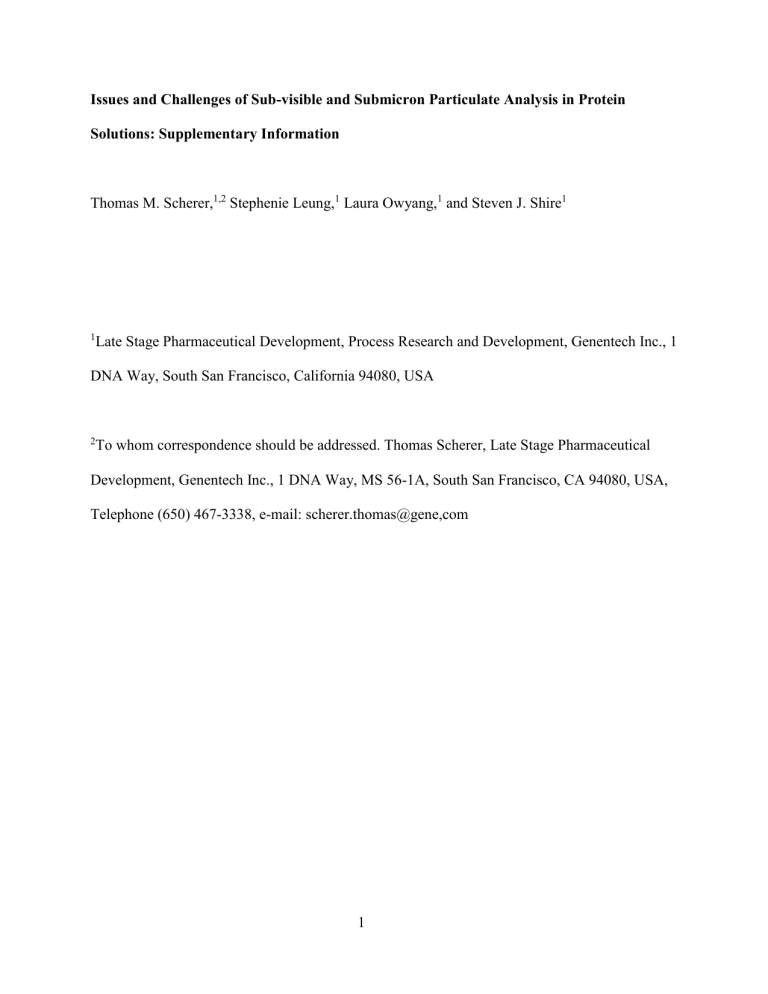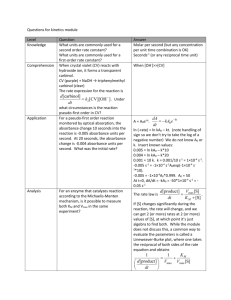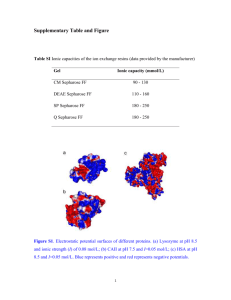Issues and Challenges of Sub-visible Particulate Analysis in Protein

Issues and Challenges of Sub-visible and Submicron Particulate Analysis in Protein
Solutions: Supplementary Information
Thomas M. Scherer,
1,2
Stephenie Leung,
1
Laura Owyang,
1
and Steven J. Shire
1
1
Late Stage Pharmaceutical Development, Process Research and Development, Genentech Inc., 1
DNA Way, South San Francisco, California 94080, USA
2
To whom correspondence should be addressed. Thomas Scherer, Late Stage Pharmaceutical
Development, Genentech Inc., 1 DNA Way, MS 56-1A, South San Francisco, CA 94080, USA,
Telephone (650) 467-3338, e-mail: scherer.thomas@gene,com
1
Supplemental Table I. Methods Evaluated for the Characterization of Particulates in High-Concentration Antibody Solutions
Method Model Manufacturer
Light obscuration
Flow microscopy
HIAC Royco 9703
Micro-Flow Imaging
TM
(MFI)
Hach Company, Loveland, CO, USA
Brightwell Technologies, Inc., Ottowa, Canada
UV-Vis spectrophotometry 8453/ G1103A
Dynamic light scattering Dynapro Titan, 30mW Dawn EOS
Agilent, Palo Alto, CA, USA,
Wyatt Technology Corporation, Santa Barbara, CA, USA
Laser diffraction
BI-DS, 2.4W Argon-ion Laser
Nanotrac Ultra
LiQuilaz 02
Brookhaven Instruments, Holtsville, NY, USA
Microtrac Inc. Montgomeryville, PA, USA
Particle Measurement Systems, Inc., Boulder, CO, USA
Bluewave Particle Size Analyzer Microtrac Inc., Montgomeryville, PA, USA
LS320 Beckman Coulter, Inc. Brea, CA, USA
2
1a
1b
Supplemental Fig. 1 . (a) Vials of MAb-A photographed at time points of 0, 8, 24, and 72 hours
(from left to right) during agitation stress. (b) Image of 72-hour agitation stressed MAb-A (10fold diluted) from microscope flow imaging analysis.
3
1400000
1200000
1000000
800000
600000
400000
200000
0
0 10 20 30 40
Vacuume Application Time (min)
50
Supplemental Figure 2: Total sub-visible particle counts > 1 um by microscope flow imaging
(high magnification) of MAb-A agitation-stressed (48 hours) sample diluted 20-fold in buffer as a function of the duration of the vacuum degassing procedure.
4
3.0
2.5
2.0
1.5
1.0
0.5
350 nm 20 nm
100 nm
560 nm
980 nm
0.0
200 300 400 500
Wavelength (nm)
600 700
Supplemental Fig. 3: Absorbance vs. wave number of monodisperse polystyrene microsphere suspensions (0.002 % wt fractions) for particle size diameters of 20, 100, 560 and 980 nm. The vertical black line indicates the absorbance wavelength of 350 nm for reference.
5
3.5
3.0
2.5
2.0
1.5
1.0
0.98 um, A350
0.98 um, A690
0.56 um, A350
0.56 um, A690
0.5
0.0
0.000
0.002
0.004
0.006
0.008
Bead Concentration (% Solids)
0.010
Supplemental Fig. 4: Absorbance at 350 and 690 nm wavelengths measured as a function of
980-nm and 560 nm diameter PS bead standards measured as a function weight fraction in suspension. Good linearity of AU vs. weight fraction was observed, however with different slopes in for each sample and wavelength. PS polystyrene
6











